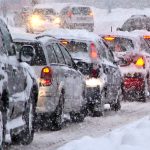Driving in The Snow
Snow is not too common on the streets of London, which makes it tricky to deal with! In order to ensure a safer driving experience, you’ll need lots of preparation and the ability to change your driving style.
If you want a comprehensive list of what to and what not to do, look no further than our special guide to driving in the snow!
Before Driving
Plan the Journey
Route planners will update you on traffic news, which can help you avoid affected areas.
Keeping up-to-date on local weather will help with decision making.
Give Yourself Extra Time
Snowy weather can affect your vehicle in many ways; if you don’t sort these out, legal measures can be taken against you:
- Driving with snow on your car is against the law – take time to clear the lights, mirrors, windows & the top of your roof.
- Make sure you de-ice the outside your windscreen, as well as clear the inside, for it’s illegal to drive without full visibility in your windows.
- Locks can get frozen, so consider using de-icing products, oil-based lubricants or simply warming the key.
Check the Windscreen Wipers
Before turning on the ignition, check that the auto wiper control is switched off. If they are frozen to the screen, this could blow the wiper control fuse when they’re turned on.
Check Your Tyres
Low quality tyres lack the grip required for snow & ice conditions. Winter tyres contain a deeper thread and so are recommended for such weather, especially in areas where snow & ice are common.
In the circumstances of really bad weather, snow socks & snow chains might be an option.
Check Your Screen-wash
A screen-wash that works at -35 to prevent water from freezing is good quality & important to have, such that your windscreen wipers are fully functional in extreme weather conditions.
Pack for The Worst
If you’re equipped with the following, you’re generally ready for all extreme weather situations:
- Demisting Pad
- Torch
- Hi-Vis Vest
- Blanket
- Spare Screen-wash
- De-Icer
- Ice Scraper
- Shovel & Spade
- Charged Phone
- Phone Charger
- Map
- First-Aid Kit
- Food & Drink
- Warning Triangle
- Jump Leads
- Square of Carpet, or anything sturdy to act as a wedge
Tips for Driving in the Snow
- Footwear should be dry & comfortable
- Acceleration should be nice & gentle. Rev low & shift to a higher gear as soon as possible
- Move off during second gear; this reduces wheel slip
- All aspects of driving – accelerating, braking, steering, gear changing – should be as smooth a process as possible
- Speed should always be kept down & more time be given to stop & steer
- Maintain a safe stopping distance between you & the car in front; leaving as much as 10 times the normal expected gap is recommended
- Prepare for uphill driving with considerable distance ahead of you, helping you avoid the need to change gear
- Use a low gear when driving downhill
- A bend should be approached by braking before steering
- Try not to panic if the car loses grip. Step off the accelerator, & have the wheels facing the direction you intend to go
- Dipped headlights should be used when driving in heavy snow, for the front & back of your vehicle
- Put your fog light on when visibility is below 100m. Ensure the lights are off if visibility returns to normal
- If a road has not been gritted, the tyre tracks of other vehicles will likely be icy, so try to drive on fresh snow where possible
- Sunglasses reduce the glare of low winter sun on the snow
- Keep the car clean. Salt used to de-ice roads can corrode the vehicle over time, so clean it regularly during the winter season.
Thankfully, snow in London never reaches the level it does across the UK, but it certainly needs paying attention to. Try your best to keep up to date with all the weather updates, routes changes and state of your car as they happen.


